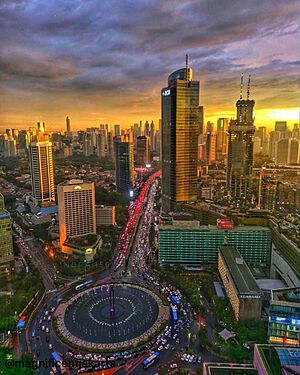Bank Central Asia facts for kids
 |
|

The BCA Tower on the right
|
|
| Public | |
| Traded as | IDX: BBCA |
| Industry | Financial services |
| Founded | 1955 (as NV Perseroan Dagang Dan Industrie Semarang Knitting Factory) 21 February 1957 (as PT Bank Central Asia Tbk) |
| Founder | Liem Sioe Liong |
| Headquarters | BCA Tower, Central Jakarta, Jakarta, Indonesia |
|
Key people
|
Djohan Emir Setijoso (President Commissioner), Jahja Setiaatmadja (President Director), Suwignyo Budiman (Deputy President Director), Armand Wahyudi (Deputy President Director) |
| Products | Consumer banking, corporate banking, Credit cards, investment banking, mortgage loans, private banking |
|
Operating income
|
Rp 50.4 trillion (2022) |
| Rp 40.7 trillion (2022) | |
| Total assets | Rp 5514.7 trillion (2022) |
| Owner | Liem Sioe Liong/Salim Group (1957 – 1998)
|
|
Number of employees
|
50,376 (2022) |
| Subsidiaries |
|
Bank Central Asia (BCA) is a very important bank in Indonesia. It was started on February 21, 1957. As of 2022, it was the biggest private bank in Indonesia. It had a lot of money, called assets, which were about Rp 5,529.83 trillion. That's a huge amount! BCA's main office is in the BCA Tower in Jakarta.
BCA was first started by a group called Salim Group. Later, a famous banker named Mochtar Riady helped it grow even more. The bank became very big in the 1980s and 1990s. It worked with other big companies like PT Telkom and Citibank. However, BCA faced big problems during the 1997 Asian financial crisis and riots in 1998. The Indonesian government had to help the bank. Later, another big company called Djarum bought it.
After these tough times, BCA became strong again. In 2000, it became a "public company." This means its shares could be bought and sold by anyone. In 2022, Forbes magazine even called Bank Central Asia the "Best Bank in Indonesia."
Contents
How Bank Central Asia Started
Bank Central Asia began in 1955. It was first called "NV Perseroan Dagang Dan Industrie Semarang Knitting Factory." A businessman named Lim Sioe Liong founded it. The bank officially started its work on February 21, 1957. Its first main office was in Jakarta.
On September 2, 1975, the bank's name was officially changed to PT Bank Central Asia (BCA). In 1977, BCA got a special license. This allowed it to work as a Foreign Exchange Bank. This meant it could handle money from other countries.
Growing and Modernizing
Around 1980, BCA started opening many more branches. This happened because new rules made it easier for banks to grow in Indonesia. BCA also began using new technology. It set up an online system for all its branches. This helped them connect and work together better. The bank also launched new products, like the popular Tahapan savings accounts.
In the 1990s, BCA started using automated teller machines (ATMs). These machines let customers do banking tasks by themselves. By 1991, BCA had 50 ATMs in Jakarta. The bank kept adding more ATMs and new features. BCA also worked with companies like PT Telkom and Citibank. This allowed BCA customers to pay their phone bills or credit card bills using BCA ATMs.
Facing Challenges and Recovering
BCA faced a very difficult time during the 1997 Asian financial crisis. Many people got scared and tried to take their money out of the bank. In 1998, the bank was in trouble. The Indonesian government, through a group called the Indonesian Bank Restructuring Agency (IBRA), had to step in and help BCA.
In 1999, the government fully helped BCA get back on its feet. The government owned most of BCA's shares for a while. In 2000, the government started selling some of its BCA shares to the public. This was called an "initial public offering" (IPO). It meant that regular people could buy parts of the bank. Over the next few years, the government sold more and more of its shares. By 2005, the government no longer owned any part of BCA.
New Services and Digital Banking
After recovering, BCA focused on making its services better. It especially worked on electronic banking. BCA launched Debit BCA and Tunai BCA. It also introduced KlikBCA for internet banking and m-BCA for mobile banking. These services made it easier for customers to manage their money from anywhere.
In 2007, BCA was one of the first banks to offer fixed-rate mortgage products. These loans helped people buy homes with steady payments. BCA also launched its Flazz Card, a special card for payments. It also started Weekend Banking, allowing people to do banking even on weekends.
From 2010 to 2013, BCA started new types of businesses. These included Islamic banking, loans for motorcycles, general insurance, and capital markets. In 2013, BCA took full ownership of its insurance company, PT Asuransi Umum BCA.
From 2014 to 2016, BCA continued to innovate. It developed MyBCA, a self-service digital banking area. It also expanded its ATM network with machines that could recycle cash. BCA launched the Sakuku app, which is like an electronic wallet for phones. The bank also made it easier to pay for things online. In 2018, BCA added a new feature to its m-BCA and Sakuku apps. This allowed people to send money to each other using QR codes.
In October 2019, BCA bought another bank called PT Bank Royal Indonesia. After buying it, BCA changed Bank Royal into a digital-only bank. This helped BCA offer even more digital services to its customers.

